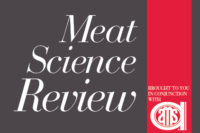Meat Science Review
Mechanism of tenderness in distillers grains-fed cattle

Our hypothesis was WDGS in feedlot diets increased polyunsaturated fatty acids (PUFA) concentration in the membrane of a calcium-holding organelle inside the cell, making the organelle membrane less stable. An unstable organelle membrane might result in more rapid calcium leakage post-rigor and thus improve tenderness through improved activation of calcium-dependent proteolytic enzymes (the calpain system).
To test our theory, 96 steers were finished on either an all-corn or 50 percent WDGS diet. Fifteen strip loins from each treatment were collected, aged and displayed under retail conditions. We measured tenderness, proteolysis, free calcium concentrations and lipid oxidation. The fatty acid, lipid and phospholipid profiles of the calcium holding organelle were also determined.
Steaks from steers fed WDGS were 1.5 pounds more tender (measured by Warner-Bratzler Shear Force) and had higher free calcium concentrations early postmortem compared to steaks from steers fed corn only. A difference of 1.5 pounds can easily be detected by average consumers. Extended aging, however, mitigated these tenderness differences as corn samples eventually caught up to WDGS samples. Feeding WDGS also increased proportions of PUFA and decreased total phospholipid in the calcium holding organelle.
Phospholipids in the SR membrane are degraded during postmortem aging. It has been suggested that calcium leaks through channels formed by the degradation. Perhaps phospholipids containing more PUFA are more susceptible to degradation, resulting in early post-rigor calcium release. The increased free calcium would accelerate calpain enzyme activation, thus improve early postmortem muscle tenderization.
Not all results supported our hypothesis, however. Proteolysis (measured by troponin-T degradation) was not different between the two treatments in any aging or retail display period. In addition, steaks from corn-fed steers also had higher lipid oxidation values compared with steaks from steers fed WDGS. The reason behind these confounding results is unclear.
These results suggested the differences in the fatty acids profile of a calcium-holding organelle are likely not the sole contributors for differences in tenderness and free calcium concentrations of beef from cattle fed high concentration of WDGS versus corn only. We continue to work to understand the mechanism by which beef from cattle fed WDGS might possess a tenderness advantage.
Michael Chao is a graduate student at the University of Nebraska who placed third in the Ph.D. graduate student research poster competition at the AMSA 67th RMC in Madison, Wis., this past June. Chris Calkins is a professor of animal science at the University of Nebraska.
Looking for a reprint of this article?
From high-res PDFs to custom plaques, order your copy today!





